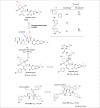Recent discovery and development of inhibitors targeting coronaviruses
- PMID: 32006468
- PMCID: PMC7102522
- DOI: 10.1016/j.drudis.2020.01.015
Recent discovery and development of inhibitors targeting coronaviruses
Abstract
Human coronaviruses (CoVs) are enveloped viruses with a positive-sense single-stranded RNA genome. Currently, six human CoVs have been reported including human coronavirus 229E (HCoV-229E), OC43 (HCoV-OC43), NL63 (HCoV-NL63), HKU1 (HCoV-HKU1), severe acute respiratory syndrome (SARS) coronavirus (SARS-CoV), and MiddleEast respiratory syndrome (MERS) coronavirus (MERS-CoV). They cause moderate to severe respiratory and intestinal infections in humans. In this review, we focus on recent advances in the research and development of small-molecule anti-human coronavirus therapies targeting different stages of the CoV life cycle.
Copyright © 2020 Elsevier Ltd. All rights reserved.
Figures














References
-
- Masters P.S., Perlman S. In: Knipe D.M., Howley P.M., editors. vol. 2. Lippincott Williams & Wilkins; 2013. pp. 825–858. (Fields Virology).
-
- Hamre D. A new virus isolated from the human respiratory tract. Proc. Soc. Exp. Biol. Med. 1966;121:190–193. - PubMed
Publication types
MeSH terms
Substances
LinkOut - more resources
Full Text Sources
Other Literature Sources
Miscellaneous

